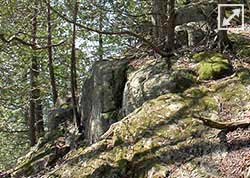Landscape Lenses
Physical Landscape : Bedrock Geology

outcropping of bedrockBedrock is the foundation of the Vermont landscape, as well as its oldest component. Composed of minerals that formed in the earth’s crust and ancient oceans, bedrock provides the raw material that forms soils and nourishes plants and animals. Although usually buried from view by overlying sediment, soil, and vegetation, the underlying bedrock also controls much of the landscape’s topography, and consequently plays a major role in determining the human and natural history of Vermont. The minerals found in different kinds of bedrock are often commercially valuable, and the chemical nature of bedrock in turn influences soil structure and chemistry.
Dolostone, for example, is a carbonate-rich rock similar to limestone that underlies much of the Burlington landscape. It can be seen and touched on the Rock Point property in a unique outcropping known as the Champlain Thrust Fault.
 The most up-to-date map of the bedrock geology of Vermont was released in 2013 and can be viewed at the Vermont Geological Survey website.
The most up-to-date map of the bedrock geology of Vermont was released in 2013 and can be viewed at the Vermont Geological Survey website.
Equipped with this map, you can go for a walk or drive around Burlington and look for outcroppings of these various rock types. Visit the UVM Redstone Quarry Natural Area for an exquisite example of Monkton Quartzite or walk out to Rock Point to see the cedar bluff forests that grow atop the Dunham Dolostone.
Key features to look for are the general form—is the rock sharp and blocky or round and blob-like?—and color as well as more finely-detailed features like texture. As you find outcrops, don’t forget to notice the other features found nearby such as a stone foundation, a grove of sugar maples, or a small porcupine den.
As dolostone weathers, it provides many important nutrients for plant growth such as calcium and magnesium. These cations (positively charged ions) buffer soil acidity and thus aid plants in nutrient uptake. Certain plants, such as ebony sedge and wild columbine, thrive in this more neutral soil environment, and certain unique natural communities are found only along the dolostone rock bluffs of Lake Champlain.
A look at the Vermont bedrock geology map (see right) will reveal that the landscape is diverse and complex. Particularly in Burlington, there is a tight banding of Cambrian (~540-490 millions years ago)-and Ordivican (~490-440 mya)-era rocks composed of limestone, dolostone, shale, and sandstone.